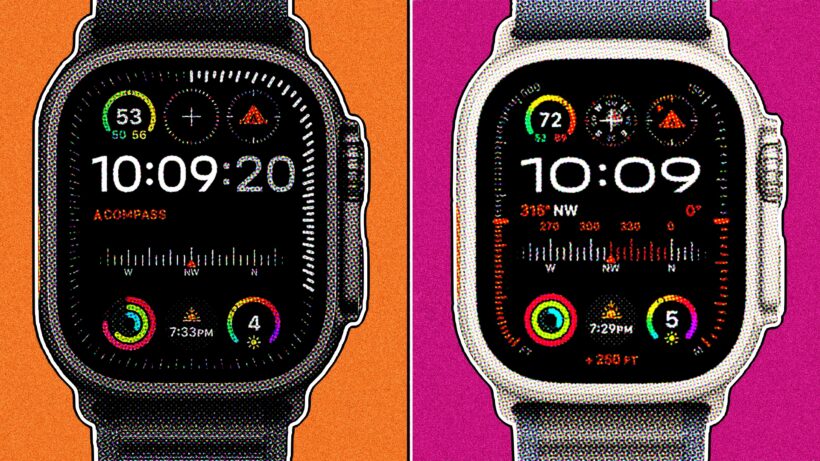If you're an Apple Watch Ultra 2 user tempted by the latest generation, use this guide to weigh up the upgrades
Two years have passed, and the Apple Watch Ultra 2 now has a successor. The Cupertino giant officially unveiled the Apple Watch Ultra 3, the next generation of its premium, outdoor smartwatch, at its ‘Awe Dropping’ event on September 9.
At first glance, the Ultra 3 brings at least one game-changing new feature to the table. Yet, is it enough to make the latest generation a must-have upgrade for current owners, or is it simply part of a more modest refinement?
As with any new launch, it’s a difficult question to answer—and it’s worth noting from the outset that we’ll need to spend considerable time testing both watches against one another in the wild to deliver a final verdict.
Consider this version 1 of our comparison ahead of an update once our Ultra 3 review is complete in a few weeks. In the meantime, here’s our early breakdown of how the Ultra 3 stacks up against the Ultra 2 based on everything we know so far.
Price and availability
The Ultra 3 launches at the same $799 price point in the US as its predecessor did in 2023. In some regions, like the UK, it’s actually launching at a slightly lower price (£749 compared to the Ultra 2’s £799 launch price), which is a welcome surprise.
As is often the case with Apple’s previous-generation devices, the Ultra 2 is no longer officially sold by the brand. However, there are still likely many third-party retailers with stock to clear in the coming months—and, of course, it’s almost certain to be offered at a lower price than the Ultra 3’s MSRP. We’ve included a live widget below to help you find the best price quickly.
Design and display

The size, shape, thickness, materials, and colors of the Ultra 3’s cases are the same as its predecessor, so there are no major changes here. And, since this was also true for the original Ultra (except for the black titanium color option), it means you’re unlikely to tell which generation someone is wearing at first glance.
However, Apple did announce that the display on the latest generation is the ‘largest ever on an Apple Watch’, with borders that are 24% thinner than on the Ultra 2. We expect this to be noticeable when the two smartwatches are side by side, and it’s always a welcome upgrade; however, it’s unlikely to be a dramatic difference or a reason to upgrade.
We should also note that the display technology itself is different on the Ultra 3, not just the size. Apple states it features a more power-efficient (more on this below) LTPO3 and wide-angle OLEDs, as well as being brighter than the Ultra 2 when viewed from an angle. Again, that’s one we’ll need to test in different lighting conditions to see if it’s a genuinely noticeable difference.
Features and tracking

This is where the biggest upgrade is; the Apple Watch Ultra 3 includes Emergency SOS via satellite.
This could be a game-changing feature for the watch’s target users—outdoor enthusiasts—as it allows them to send emergency messages, contact friends and family, and share their Find My location, even when completely off the grid and without any cellular or Wi-Fi signal.
For serious hikers, climbers, and trail runners, this is a potentially life-saving tool that brings the Ultra 3 into direct competition with other dedicated satellite/SOS features that have popped up in 2025.
The interpretation found in the Garmin Fenix 8 Pro is most comparable to Apple’s Ultra 3. However, we’ll wait until we’ve had the chance to get outdoors with those two side-by-side to provide a full breakdown of how they work and which performs better in practice.
Google’s Pixel Watch 4 lineup also features new emergency SOS features via satellite. Still, it’s inherently more limited than Apple’s (or Garmin’s) feature here, and it’s also not a direct rival to the Ultra lineup.
For the avoidance of doubt here, the Ultra 2 doesn’t possess these powers and won’t be receiving them, given that it’s a hardware change and not a software feature.
On that note, though, the two share an almost identical feature set aside from this feature. Both will receive the new health features and smarts announced for the latest editions via watchOS 26, including the hypertension notifications, Workout Buddy, Sleep Score, and the wrist flick gesture.
Battery life and performance

Battery life has always been a key strength of the Ultra line, relatively speaking—and things are set to be quite different between the new-generation and last-gen models.
The Ultra 2 was officially rated for 36 hours of normal use, which we found easily and very consistently stretched to two full days in long-term testing. The Ultra 3 gets a welcome boost in this department, with Apple now quoting up to 42 hours of battery life.
Even on paper, this is a significant improvement. It might not seem like a big leap, but those extra six hours could be the difference that comfortably extends the watch into a third full day of use on a multi-day trip, helping to ease battery anxiety for adventurers.
And again, that’s probably the minimum we can expect. Apple states the Ultra 3, like the Ultra 2, is rated for 72 hours in Low Power Mode. However, this could be the first Ultra to last three days with a combination of AOD and battery-saver mode—especially considering the potential efficiency improvements from the display changes discussed above.
Like other areas, it’s an area we’re eager to analyze alongside the Ultra 2 through extended testing.
Early verdict
Again, we’ll note that we’re not ready to give a final recommendation on which of these smartwatches is best for your wrist until our Ultra 3 review goes live.
However, the decision to upgrade from an Apple Watch Ultra 2 to the Ultra 3 seems to hinge almost entirely on one question: how much time do you spend in the great outdoors without a reliable phone signal?
If you’re a serious adventurer who frequently finds themselves off-grid, the addition of satellite SOS is a massive safety feature that could absolutely justify the upgrade.
It’s a pro-level tool for a pro-level user—and one that you’re not paying extra for, like with Garmin (although, by requiring a cellular plan for your Ultra 3, you are technically still paying ‘extra’… just to a carrier instead of the device maker).
For everyone else, the Ultra 3 is more of an iterative update. The slightly bigger screen and longer battery life are nice refinements, but perhaps not essential. Since all the major new health features are coming to the Ultra 2 via the watchOS 26 software update, many users will likely find their current device is more than powerful enough for another year (at least).




